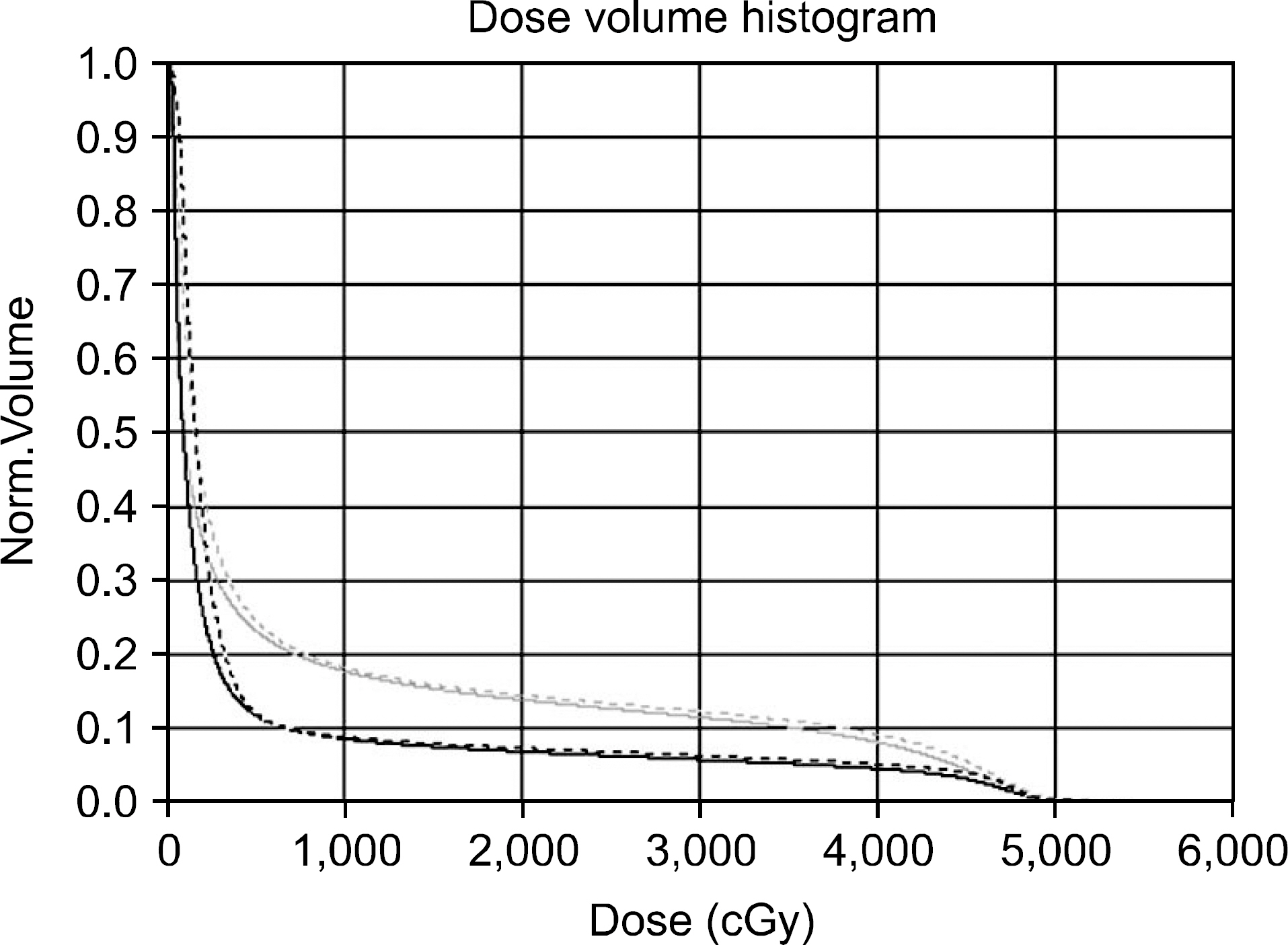Prog Med Phys.
2014 Dec;25(4):199-204. 10.14316/pmp.2014.25.4.199.
Dosimetric Advantages of the Field-in-field Plan Compared with the Tangential Wedged Beams Plan for Whole-breast Irradiation
- Affiliations
-
- 1Department of Radiation Oncology, Seoul National University Boramae Medical Center, Seoul, Korea. kimsuzy@hanmail.net
- KMID: 2315757
- DOI: http://doi.org/10.14316/pmp.2014.25.4.199
Abstract
- The purpose of this study is to evaluate the dosimetric outcome of the field-in-field (FIF) plans compared with tangential wedged beams (TWB) plans for whole breast irradiation of breast cancer patients. Twenty patients with right-sided breast cancer and 10 patients with left-sided breast cancer were retrospectively enrolled in this study. We generated a FIF plan and a TWB plan for each patient to compare dosimetric outcomes. The dose the homogeneity index (HI), the conformity index (CI) and the uniformity index (UI) were defined and used for comparison of the dosimetric outcome of the planning target volume (PTV). To compare the dosimetric outcome of the organs at risk, the mean dose (Dmean) and the percentage of volumes receiving more than 10, 20 and 30 Gy of the ipsilateral lung and heart were used. The FIF plans had significantly lower HI (p=0.002), higher UI (p=0.000) and CI (p=0.000) than those of the TWB plans, which means that the FIF plans were better than the TWB plans in the dosimetric comparisons of the PTV. The V10lung (17.1+/-7.1 vs. 18.6+/-6.6%, p=0.020) and V30lung (10.3+/-5.1% vs. 10.7+/-5.2%, p=0.000) were lower with the FIF plans compared with those of the TWB plans, with statistical significance. For the left-sided breast cancer patients, Dmean of the heart (2.6+/-1.3 vs. 3.2+/-1.4 Gy, p=0.000), V20heart (3.4+/-2.6 vs. 3.6+/-2.8%, p=0.005) and V30heart (2.6+/-2.3% vs. 2.9+/-2.4%, p=0.004) were significantly lower for the FIF plans in comparison with those of the TWB plans. The FIF plans increased the dose homogeneity, conformity and uniformity of the target volume for the whole-breast irradiation compared with the TWB plans. Moreover, FIF plans reduced the doses to the ipsilateral lung and heart.
Keyword
Figure
Reference
-
References
1. Kim Z, Min SY, Yoon CS, et al. The basic facts of Korean breast cancer in 2011: results of a nationwide survey and breast cancer registry database. J Breast Cancer. 17:99–106. 2014.
Article2. Fisher B, Anderson S, Bryant J, et al. Twenty-year follow-up of a randomized trial comparing total mastectomy, lumpectomy, and lumpectomy plus irradiation for the treatment of invasive breast cancer. N Engl J Med. 347:1233–1241. 2002.
Article3. Clarke M, Collins R, Darby S, et al. Effects of radiotherapy and of differences in the extent of surgery for early breast cancer on local recurrence and 15-year survival: an overview of the randomized trials. Lancet. 17:2087–2106. 2005.4. Rapiti E, Fiorreta G, Vlastos G, et al. Breast-conserving surgery has equivalent effect as mastectomy on stage I breast cancer prognosis only when followed by radiotherapy. Radiother Oncol. 69:277–284. 2003.
Article5. Buchholz TA, Gurqoze E, Bice WS, et al. Dosimetric analysis of intact breast irradiation in off-axis planes. Int J Radiat Oncol Biol Phys. 39:261–267. 1997.
Article6. Solin LJ, Chu JC, Sontag MR, et al. Three-dimensional photon treatment planning of the intact breast. Int J Radiat Oncol Biol Phys. 21:193–203. 1991.
Article7. Sun LM, Meng FY, Yang TH, et al. Field-in-field plan does not improve dosimetric outcome compared with the wedged beams plan for breast cancer radiotherapy. Med Dosim. 39:79–82. 2014.8. Sasaoka M, Futami T. Dosimetric evaluation of whole breast radiotherapy using field-in-field technique in early-stage breast cancer. Int J Clin Oncol. 16:250–256. 2011.
Article9. Onal C, Sonmez A, Arslan G. Dosimetric comparison of the field-in-field technique and tangential wedged beams for breast irradiation. Jpn J Radiol. 30:218–226. 2012.
Article10. Barnett GC, Wilkinson J, Moody AM, et al. A randomized controlled trial of forward-planned radiotherapy (IMRT) for early breast cancer: Baseline characteristics and dosimetry results. Radiother Oncol. 92:34–41. 2009.11. Mukesh MB, Barnett GC, Wilkinson JS, et al. Randomized controlled trial of intensitymodulated radiotherapy for early breast cancer: 5-year results confirm superior overall cosmesis. J Clin Oncol 31;4488–4495 (. 2013.12. Marks LB, Yu X, Vujaskovic Z, et al. Radiation-induced lung injury. Semin Radiat Oncol. 13:333–345. 2003.
Article13. Graham MV, Purdy JA, Emami B, et al. Clinical dose-volume histogram analysis for pneumonitis after 3D treatment for non-small cell lung cancer (NSCLC). Int J Radiat Oncol Biol Phys. 45:323–329. 1999.
Article14. Claude L, Perol D, Ginestet C, et al. A prospective study on radiation pneumonitis following conformal radiation therapy in non-small cell lung cancer. Radiother Oncol. 71:175–181. 2004.15. Zhang XJ, Sun JG, Sun J, et al. Prediction of radiation pneumonitis in lung cancer patients: a systemic review. J Cancer Res Clin Oncol. 138:2103–2116. 2012.16. Blom Goldman U, Anderson M, Wennberg B, et al. Radiation pneumonitis and pulmonary function with lung dosevolume constraints in breast cancer irradiation. J Radiother Pract. 13:211–217. 2014.
Article17. Harris EE, Correa C, Hwang WT, et al. Late cardiac mortality and morbidity in early-stage breast cancer patients after breast conservation treatment. J Clin Oncol. 24:4100–4106. 2006.18. Borger JH, Hooning MJ, Boersma LJ, et al. Cardiotoxic effects of tangential breast irradiation in early breast cancer patients: the role of irradiated heart volume. Int J Radiat Oncol Biol Phys. 69:1131–1138. 2007.
Article19. Darby SC, Ewertz M, McGale P, et al. Risk of ischemic heart disease in women after radiotherapy for breast cancer. N Engl J Med. 368:987–998. 2013.
Article
- Full Text Links
- Actions
-
Cited
- CITED
-
- Close
- Share
- Similar articles
-
- Correction Method on Mismatched Posterior Edge of Medial and Lateral Tangential Fields for Three Fields Techniques in Breast Cancer
- Improved Breast Irradiation Techniques Using Multistatic Fields or Three Dimensional Universal Compensators
- Dosimetric Characteristics of Dynamic Wedge Techinique
- Dosimetric comparative study of 3DCRT, IMRT, VMAT, Ecomp, and Hybrid techniques for breast radiation therapy
- Dosimetric Effects of Intrafractional Organ Motion in Field-in-Field Technique for Whole-Breast Irradiation


